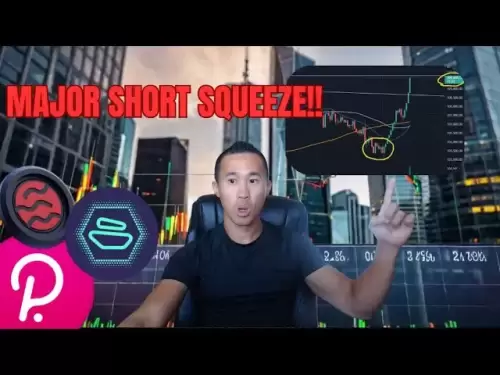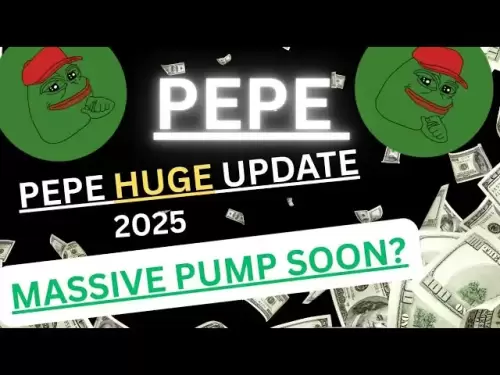-
 Bitcoin
Bitcoin $108,270.9768
2.07% -
 Ethereum
Ethereum $2,489.8066
2.50% -
 Tether USDt
Tether USDt $1.0004
0.01% -
 XRP
XRP $2.2035
0.66% -
 BNB
BNB $661.6608
2.32% -
 Solana
Solana $150.6425
2.13% -
 USDC
USDC $0.9999
-0.01% -
 TRON
TRON $0.2810
0.90% -
 Dogecoin
Dogecoin $0.1645
3.05% -
 Cardano
Cardano $0.5743
4.91% -
 Hyperliquid
Hyperliquid $38.8419
-0.15% -
 Bitcoin Cash
Bitcoin Cash $504.3134
-2.64% -
 Sui
Sui $2.8096
4.35% -
 Chainlink
Chainlink $13.3095
2.21% -
 UNUS SED LEO
UNUS SED LEO $8.9469
0.33% -
 Avalanche
Avalanche $17.9231
3.93% -
 Stellar
Stellar $0.2340
0.74% -
 Toncoin
Toncoin $2.8458
3.21% -
 Shiba Inu
Shiba Inu $0.0...01158
3.47% -
 Litecoin
Litecoin $86.0738
1.94% -
 Hedera
Hedera $0.1507
2.99% -
 Monero
Monero $319.8544
2.31% -
 Polkadot
Polkadot $3.4081
1.95% -
 Dai
Dai $1.0000
0.01% -
 Bitget Token
Bitget Token $4.5645
0.91% -
 Ethena USDe
Ethena USDe $1.0002
0.00% -
 Uniswap
Uniswap $7.2959
5.27% -
 Aave
Aave $272.4623
2.90% -
 Pepe
Pepe $0.0...09680
2.96% -
 Pi
Pi $0.4955
0.78%
What is the difference between an ERC-721 and an ERC-1155 nft?
The key difference between ERC-721 and ERC-1155 lies in token uniqueness, with ERC-721 representing fully unique assets, while ERC-1155 supports both fungible and non-fungible tokens within a single contract.
Jul 02, 2025 at 08:28 am
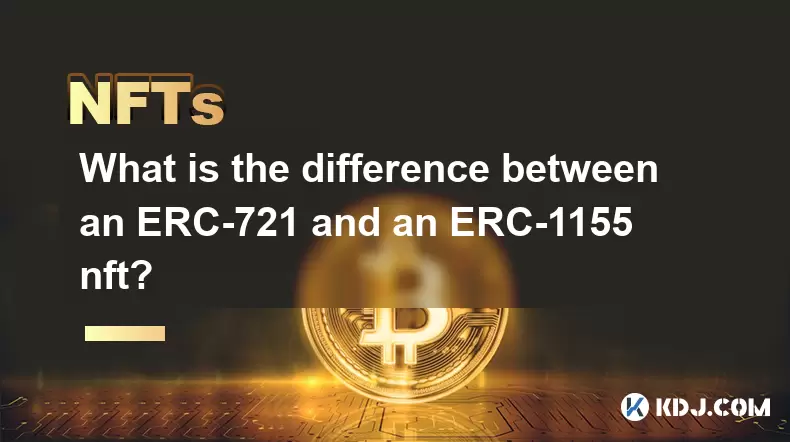
Understanding the Basics of NFT Standards
To fully grasp the difference between ERC-721 and ERC-1155, it’s essential to understand what an NFT standard is. In the Ethereum ecosystem, standards like ERC-721 and ERC-1155 define how non-fungible tokens (NFTs) are created, managed, and transferred. These standards ensure interoperability across platforms, wallets, and marketplaces.
The ERC-721 standard was the first widely adopted protocol for creating unique digital assets on the Ethereum blockchain. Each token minted under this standard is distinct and not interchangeable with another token of the same type. This makes ERC-721 ideal for representing ownership of unique items such as digital art, collectibles, or virtual real estate.
On the other hand, ERC-1155 is a more advanced standard that introduces the concept of semi-fungibility. Unlike ERC-721, which only supports unique tokens, ERC-1155 allows for both fungible and non-fungible tokens within the same contract. This flexibility enables developers to manage multiple token types more efficiently, reducing gas costs and improving scalability.
Token Uniqueness and Interchangeability
One of the core distinctions between ERC-721 and ERC-1155 lies in the nature of token uniqueness and interchangeability. In the ERC-721 framework, each token is entirely unique and cannot be replaced by another token of the same kind. For example, if you own a specific ERC-721 NFT representing a piece of digital art, no other token can substitute it because they are inherently different.
In contrast, ERC-1155 introduces the idea of batch transfers and multiple token types within a single smart contract. A game developer could use ERC-1155 to issue 10,000 identical sword NFTs (fungible) alongside one-of-a-kind character skins (non-fungible). This hybrid model means that some tokens can be interchangeable while others remain unique, depending on their defined properties.
This distinction has significant implications for use cases. ERC-721 is better suited for scenarios where individual scarcity and uniqueness are paramount, such as high-value collectibles. Meanwhile, ERC-1155 shines in environments requiring efficiency and versatility, like gaming ecosystems with numerous similar items.
Smart Contract Efficiency and Gas Costs
Another critical area where ERC-721 and ERC-1155 differ is in terms of smart contract efficiency and associated gas costs. With ERC-721, each token transfer requires a separate transaction on the Ethereum network. As a result, transferring multiple NFTs individually can become costly and inefficient, especially during times of high network congestion.
ERC-1155, however, allows for batch transfers—multiple tokens can be sent in a single transaction. This dramatically reduces the number of transactions needed and, consequently, the overall gas fees. Developers can create a single contract that handles various token types, streamlining operations and optimizing blockchain resource usage.
Additionally, ERC-1155 contracts are generally smaller in size compared to deploying multiple ERC-721 contracts for different token types. This compact structure further contributes to cost savings and faster deployment times, making ERC-1155 particularly appealing for large-scale applications.
Royalty Structures and Developer Flexibility
Both ERC-721 and ERC-1155 support royalty structures, allowing creators to earn a percentage of secondary sales. However, the implementation differs slightly between the two standards. In ERC-721, royalties are typically handled through on-chain metadata or integrated into marketplace logic. Some marketplaces enforce creator royalties, while others do not, leading to inconsistent enforcement.
With ERC-1155, royalty mechanisms can be embedded directly into the token contract itself. This ensures that every time a token is sold on any compatible platform, the original creator receives their designated cut automatically. This built-in functionality enhances trust and transparency in digital asset trading.
Moreover, ERC-1155 provides greater flexibility for developers. They can design complex token economies involving multiple item types, including limited editions, utility-based tokens, and dynamic content updates—all from a single contract. This adaptability opens up new possibilities for decentralized finance (DeFi) integrations and cross-platform interactions.
Use Cases and Adoption Trends
When considering adoption trends, ERC-721 remains the most popular standard for NFTs due to its early entry into the market and widespread support across major NFT marketplaces like OpenSea and Rarible. It has become synonymous with digital collectibles and profile picture projects such as CryptoPunks and Bored Ape Yacht Club.
However, ERC-1155 is gaining traction, particularly in gaming and metaverse applications. Platforms like Enjin and games built on the Ethereum-compatible blockchains often prefer ERC-1155 due to its efficiency in handling large inventories of both rare and common items. The ability to bundle and trade multiple assets simultaneously makes it ideal for virtual worlds where users may own dozens or hundreds of digital goods.
Furthermore, ERC-1155’s compatibility with both fungible and non-fungible tokens simplifies integration with DeFi protocols. Users can stake, lend, or collateralize a mix of token types without needing separate systems for each asset class. This convergence of functionalities highlights the growing importance of multi-token standards in the evolving Web3 landscape.
How to Choose Between ERC-721 and ERC-1155
Deciding whether to use ERC-721 or ERC-1155 depends largely on the intended use case and operational requirements. If your project involves issuing one-of-a-kind digital assets where provenance and scarcity are crucial, ERC-721 is likely the best fit. It offers simplicity, strong community support, and seamless integration with existing NFT infrastructure.
Conversely, if your application requires handling multiple token types, frequent batch operations, or a combination of fungible and non-fungible assets, ERC-1155 provides superior efficiency and scalability. Game developers, platform builders, and DeFi innovators often benefit more from the features offered by ERC-1155.
Ultimately, understanding the strengths and limitations of each standard empowers creators and developers to make informed decisions tailored to their specific needs.
Frequently Asked Questions
What are the security differences between ERC-721 and ERC-1155?
While both standards inherit Ethereum's base security, ERC-1155 introduces more complexity due to its multi-token architecture. Smart contract audits are crucial for ERC-1155 implementations to prevent vulnerabilities like improper access controls or incorrect balance tracking. ERC-721 contracts tend to be simpler, but they are not immune to bugs either.
Can I convert an ERC-721 token into an ERC-1155 token?
Technically, yes, but it requires wrapping the ERC-721 token inside a new ERC-1155 contract. This process involves locking the original token and minting a corresponding ERC-1155 version. However, conversion does not alter the underlying asset—it simply changes how it is represented and managed on-chain.
Are there wallet and marketplace limitations for ERC-1155?
Most modern wallets and marketplaces now support ERC-1155, but older platforms may lack full compatibility. Users should verify whether their preferred tools recognize ERC-1155 tokens before engaging in transactions. Major platforms like OpenSea and WalletConnect have added robust support for this standard.
Does ERC-1155 allow fractional ownership of NFTs?
No, ERC-1155 does not natively support fractional ownership. While it enables semi-fungible tokens, true fractionalization typically requires additional layers or protocols like ERC-2981 for royalties or third-party platforms that split ownership rights off-chain.
Disclaimer:info@kdj.com
The information provided is not trading advice. kdj.com does not assume any responsibility for any investments made based on the information provided in this article. Cryptocurrencies are highly volatile and it is highly recommended that you invest with caution after thorough research!
If you believe that the content used on this website infringes your copyright, please contact us immediately (info@kdj.com) and we will delete it promptly.
- XRP Price Targets $2.40 After Descending Channel Breakout: Is $40 Next?
- 2025-07-03 08:50:12
- All Blacks' Loose Forward Conundrum: New Faces and Familiar Battles
- 2025-07-03 08:30:12
- Bitcoin's Wild Ride: Open Interest, Institutional Bets, and Billions on the Line
- 2025-07-03 08:30:12
- Bitcoin, Strategy, & Profit: MSTR's Crypto Playbook and Trump's Digital Diversification
- 2025-07-03 08:50:12
- Bitcoin on the Brink: Active Supply Signals Potential Rally
- 2025-07-03 06:30:12
- Solana, XRP, SEI: Altcoin Titans and the Next Big Thing
- 2025-07-03 06:50:12
Related knowledge
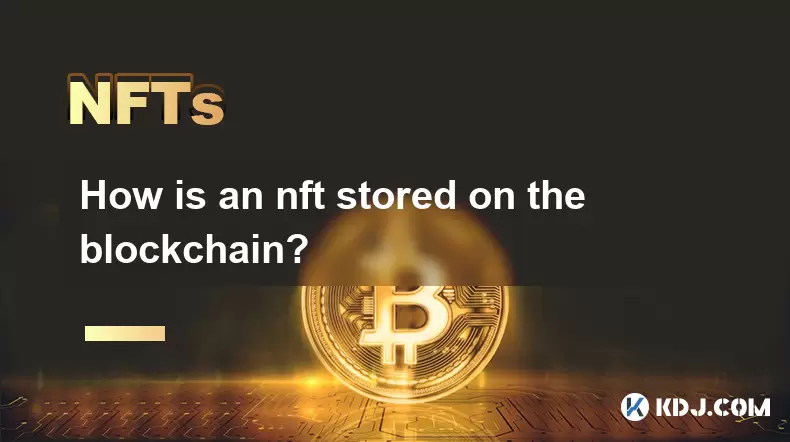
How is an nft stored on the blockchain?
Jul 01,2025 at 04:07am
How Is an NFT Stored on the Blockchain?Non-Fungible Tokens (NFTs) have revolutionized how digital assets are owned, verified, and transferred. Understanding how an NFT is stored on the blockchain provides clarity on its uniqueness, immutability, and traceability. Understanding the Basic Structure of an NFTAn NFT is a unique token that represents ownersh...
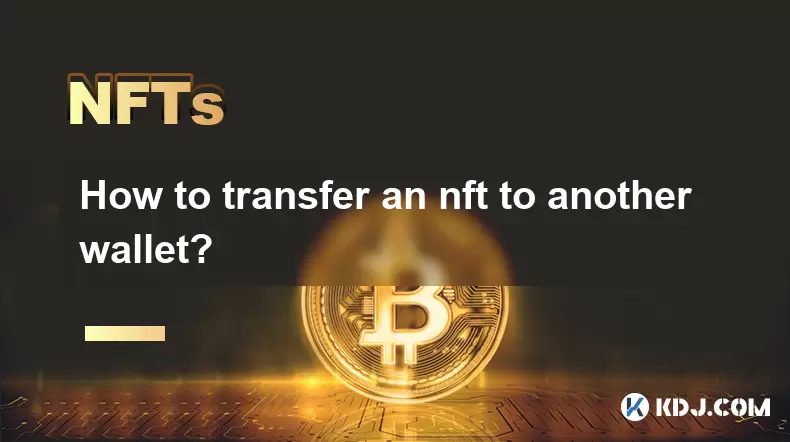
How to transfer an nft to another wallet?
Jul 01,2025 at 10:21am
Understanding the Basics of NFT TransfersTransferring an NFT (Non-Fungible Token) from one wallet to another is a common operation in the blockchain space. Before proceeding, it's crucial to understand what an NFT represents: a unique digital asset stored on a blockchain, typically Ethereum or other compatible chains like Binance Smart Chain or Solana. ...
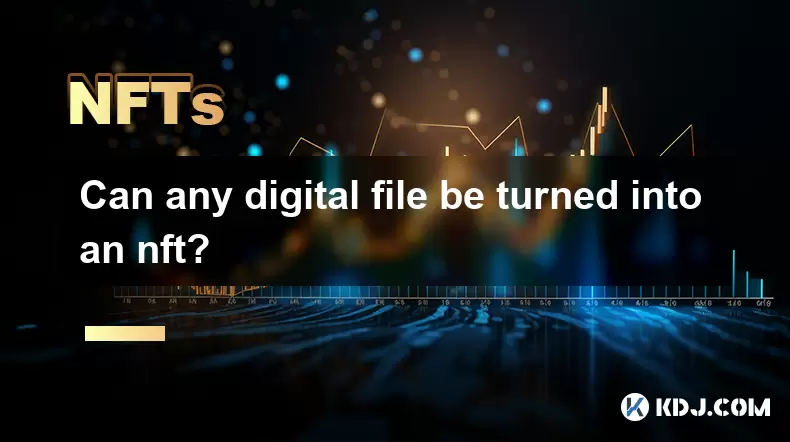
Can any digital file be turned into an nft?
Jul 01,2025 at 07:00am
Understanding the Concept of NFTsAn NFT (Non-Fungible Token) is a unique digital certificate of ownership stored on the blockchain. Unlike cryptocurrencies such as Bitcoin or Ethereum, which are fungible and interchangeable, NFTs represent one-of-a-kind assets that cannot be replicated or replaced. These tokens can represent various types of digital fil...

What are the best nft analytics tools?
Jul 02,2025 at 03:49am
Understanding the Role of NFT Analytics ToolsIn the fast-evolving world of non-fungible tokens (NFTs), data-driven decisions are crucial for creators, investors, and collectors. NFT analytics tools serve as a bridge between raw blockchain data and actionable insights. These platforms aggregate information from various blockchains to offer detailed metri...

How to analyze an nft project's roadmap?
Jul 01,2025 at 12:01pm
What is an NFT Project Roadmap?An NFT project roadmap serves as a strategic plan outlining the development goals, milestones, and timelines for a non-fungible token initiative. It typically includes short-term and long-term objectives, key deliverables, team updates, partnerships, and community engagement strategies. A well-structured roadmap helps inve...

What is the difference between an ERC-721 and an ERC-1155 nft?
Jul 02,2025 at 08:28am
Understanding the Basics of NFT StandardsTo fully grasp the difference between ERC-721 and ERC-1155, it’s essential to understand what an NFT standard is. In the Ethereum ecosystem, standards like ERC-721 and ERC-1155 define how non-fungible tokens (NFTs) are created, managed, and transferred. These standards ensure interoperability across platforms, wa...

How is an nft stored on the blockchain?
Jul 01,2025 at 04:07am
How Is an NFT Stored on the Blockchain?Non-Fungible Tokens (NFTs) have revolutionized how digital assets are owned, verified, and transferred. Understanding how an NFT is stored on the blockchain provides clarity on its uniqueness, immutability, and traceability. Understanding the Basic Structure of an NFTAn NFT is a unique token that represents ownersh...

How to transfer an nft to another wallet?
Jul 01,2025 at 10:21am
Understanding the Basics of NFT TransfersTransferring an NFT (Non-Fungible Token) from one wallet to another is a common operation in the blockchain space. Before proceeding, it's crucial to understand what an NFT represents: a unique digital asset stored on a blockchain, typically Ethereum or other compatible chains like Binance Smart Chain or Solana. ...

Can any digital file be turned into an nft?
Jul 01,2025 at 07:00am
Understanding the Concept of NFTsAn NFT (Non-Fungible Token) is a unique digital certificate of ownership stored on the blockchain. Unlike cryptocurrencies such as Bitcoin or Ethereum, which are fungible and interchangeable, NFTs represent one-of-a-kind assets that cannot be replicated or replaced. These tokens can represent various types of digital fil...

What are the best nft analytics tools?
Jul 02,2025 at 03:49am
Understanding the Role of NFT Analytics ToolsIn the fast-evolving world of non-fungible tokens (NFTs), data-driven decisions are crucial for creators, investors, and collectors. NFT analytics tools serve as a bridge between raw blockchain data and actionable insights. These platforms aggregate information from various blockchains to offer detailed metri...

How to analyze an nft project's roadmap?
Jul 01,2025 at 12:01pm
What is an NFT Project Roadmap?An NFT project roadmap serves as a strategic plan outlining the development goals, milestones, and timelines for a non-fungible token initiative. It typically includes short-term and long-term objectives, key deliverables, team updates, partnerships, and community engagement strategies. A well-structured roadmap helps inve...

What is the difference between an ERC-721 and an ERC-1155 nft?
Jul 02,2025 at 08:28am
Understanding the Basics of NFT StandardsTo fully grasp the difference between ERC-721 and ERC-1155, it’s essential to understand what an NFT standard is. In the Ethereum ecosystem, standards like ERC-721 and ERC-1155 define how non-fungible tokens (NFTs) are created, managed, and transferred. These standards ensure interoperability across platforms, wa...
See all articles





















